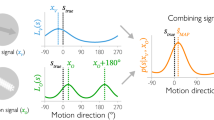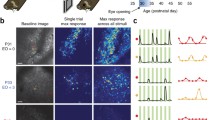Abstract
A technique is described and tested for mapping the sensitivities and preferred directions of motion at different locations within the receptive fields of direction-selective motion-detecting visual neurons. The procedure is to record the responses to a number of visual stimuli, each stimulus presentation consisting of a set of short, randomly-oriented, moving bars arranged in a square grid. Each bar moves perpendicularly to its long axis. The vector describing the sensitivity and preferred direction of motion at each grid location is obtained as a sum of the unit vectors defining the directions of motion of the bars in each of the stimuli at that location, weighted by the strengths of the corresponding responses. The resulting vector field specifies the optimum flow field for the neuron. The advantage of this technique over the conventional approach of probing the receptive field sequentially at each grid location is that the parallel nature of the stimulus is sensitive to nonlinear interactions (such as shunting inhibition for mutual facilitation) between different regions of the visual field. The technique is used to determine accurately the motion receptive fields of direction-selective motion detecting neurons in the optic lobes of insects. It is potentially applicable to motion-sensitive neurons with highly structured receptive fields, such as those in the optic tectum of the pigeon or in area MST of the monkey.
Similar content being viewed by others
References
Dubs A (1982) The spatial integration of signals in the retina and lamina of the fly compound eye under different conditions of luminance. J Comp Physiol 146:321–343
Dvorak DR, Srinivasan MV, French AS (1980) The contrast sensitivity of fly movement-detecting neurons. Vision Res 20:397–407
Frost BJ, Wylie DR, Wang YC (1990) The processing of object and self-motion in the tectofugal and accessory optic pathways of birds. Vision Res 30:1677–1688
Gibson JJ (1950) The perception of the visual world. Houghton Miffin, Boston
Hateren JH van (1990) Directional tuning curves, elementary movement detectors and the estimation of the direction of visual movement. Vision Res 30:603–614
Hausen K (1982) Motion sensitive interneurons in the optomotor system of the fly. II. The horizontal cells: receptive field organization and response characteristics. Biol Cybern 46:67–79.
Hausen K (1984) The lobula plate complex of the fly: structure,function and significance in visual behavior. In: Ali MA (eds) Photoreception and vision in invertebrates. Plenum Press, New York London, Ser 74, pp 523–560
Hausen K, Egelhaaf M (1989) Neural mechanisms of visual course control in insects. In: Stavenga DG, Hardie RC (eds) Facets of vision. Springer-Verlag, Berlin Heidelberg New York, pp 391–424
Ibbotson MR, Maddess T, DuBois R (1991) A system of insect neurons sensitive to horizontal and vertical image motion connects the medulla and midbrain. J Comp Physiol 169:355–367
Jin ZF (1991) Computational studies of visual motion processing. Ph. D. thesis, Australian National University 1991
Kirkpatrick S, Gelatt CD, Vecchi MP (1983) Optimization by simulated annealing. Science 220:617–620
Maddess T, Laughlin SB (1985) Adaptation of the motion-sensitive neuron H1 is generated locally and governed by contrast frequency. Proc R Soc London Ser B 225:251–275
Nakayama K (1985) Biological image motion processing: a review. Vision Res 25:625–660
Papoulis A (1965) Probability, random variables and stochastic processes. McGraw-Hill, New York
Ruyter van Steveninck RR de, Zaagman WH, Masterbroek HAK (1986) Adaptation of transient responses of a movement-sensitive neuron in the visual system of the blowfly Calliphora erythrocephala. Biol Cybern 54:223–236
Srinivasan MV, Dvorak DR (1980) Spatial processing of visual information in the movement-detecting pathway of the fly. J Comp Physiol 140:1–23
Tanaka K, Yoshiro F, Saito H (1989) Underlying mechanisms of the response specificity of expansion/contraction and rotation cells in the dorsal part of the medial superior temporal area of the macaque monkey. J Neurophysiol 62(3):642–656
Tzanakou E, Michalak R, Harth E (1979) The Alopex process: visual receptive fields by response feedback. Biol Cybern 35:161–174
Author information
Authors and Affiliations
Rights and permissions
About this article
Cite this article
Srinivasan, M.V., Jin, Z.F., Stange, G. et al. ‘Vector white noise’: a technique for mapping the motion receptive fields of direction-selective visual neurons. Biol. Cybern. 68, 199–207 (1993). https://doi.org/10.1007/BF00224852
Received:
Accepted:
Issue Date:
DOI: https://doi.org/10.1007/BF00224852




